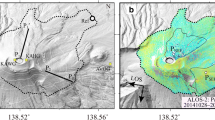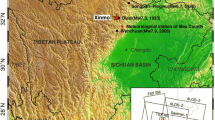Abstract
Mapping the three-dimensional (3D) displacement fields associated with a variety of geological phenomena has been widely performed by exploiting synthetic aperture radar (SAR) imagery, as the result is important for providing insight into the formation mechanisms and potential risks of geological hazards. New-generation SAR sensors, namely ALOS-2 and Sentinel-1, can capture surface deformation with a high coherence in wide-swath mode, thereby providing outstanding across-track displacement accuracies; however, this improvement partially sacrifices the azimuth resolution, which affects the retrieval of 3D surface deformation fields. To explore the feasibility of generating 3D deformation maps with new SAR imagery, we collect two pairs of ALOS-2 ScanSAR and four pairs of Sentinel-1 Terrain Observation by Progressive Scans (TOPS) images for the 12 November 2017 Ezgeleh earthquake. Furthermore, the differential interferometric SAR (DInSAR), pixel offset tracking (POT), multiple-aperture InSAR (MAI), and burst-overlap interferometry (BOI) methods are used to measure the across- and along-track displacements. Compared with the POT and MAI methods, the integration of DInSAR and BOI measurements provides high-quality 3D deformation maps with an accuracy of 4 cm, which is four times and two times better than the accuracies of the POT and MAI methods integrated with DInSAR, respectively. In addition, a significant north–south displacement of 0.76 m is found in our 3D deformation results that was underestimated in the slip distribution model constrained with seismic waveforms or InSAR measurements. Our 3D deformation map of the 2017 Ezgeleh earthquake indicates a southwestward horizontal motion and an upward motion without any corresponding surface rupture that effectively match the behavior of a blind rupture along a northeast-dipping reverse fault. We conclude that combining BOI with DInSAR would provide a better 3D deformation field and should be applied to study future earthquakes.












Similar content being viewed by others
References
Bechor NB, Zebker HA (2006) Measuring two-dimensional movements using a single InSAR pair. Geophys Res Lett 33:L16311. https://doi.org/10.1029/2006GL026883
Chen CW, Zebker HA (2000) Network approaches to two-dimensional phase unwrapping: intractability and two new algorithms. J Opt Soc Am 17:401–414
De Zan Z, Guarnieri AM (2006) TOPSAR: Terrain Observation by Progressive Scans. IEEE Trans. Geosci Remote Sens. https://doi.org/10.1109/TGRS.2006.873853
Ding KH, He P, Wen YM, Chen YG, Wang D, Li SH, Wang Q (2018) The 2017 Mw 7.3 Ezgeleh, Iran earthquake determined from InSAR measurements and teleseismic waveforms. Geophys J Int (under review)
Erten E, Reigber A, Hellwich O (2010) Generation of three-dimensional deformation maps from InSAR data using spectral diversity techniques. ISPRS J Photogramm 65(4):388–394
Eslami A, Kohi AM, Taghaboni M, Kamizi A (2017) Preliminary report of the earthquake on November 12, 2017, Sarpolzahab, Kermanshah province
Farr TG, Rosen PA, Caro E, Crippen R, Duren R, Hensley S, Seal D (2007) The shuttle radar topography mission. Rev Geophys. https://doi.org/10.1029/2005RG000183
Fialko Y, Simons M, Agnew D (2001) The complete (3-D) surface displacement field in the epicentral area of the 1999 Mw 7. 1 Hector Mine earthquake, California, from space geodetic observations. Geophys Res Lett 28(16):3063–3066
Fialko Y, Sandwell D, Simons M, Rosen P (2005) Three-dimensional deformation caused by the Bam, Iran, earthquake and the origin of shallow slip deficit. Nature 435(7040):295–299
Gabriel AK, Goldstein RM, Zebker HA (1989) Mapping small elevation changes over large areas: differential radar interferometry. J Geophys Res Solid Earth 94(B7):9183–9191
Goldstein RM, Werner CL (1998) Radar interferogram filtering for geophysical applications. Geophys Res Lett 25(21):4035–4038
Gourmelen N, Kim SW, Shepherd A, Park JW, Sundal AV, Björnsson H, Pálsson F (2011) Ice velocity determined using conventional and multiple-aperture InSAR. Earth Planet Sci Lett 307(1):156–160
Grandin R, Klein E, Métois M, Vigny C (2016) Three-dimensional displacement field of the 2015 Mw 8.3 Illapel earthquake (Chile) from across- and along-track Sentinel-1 TOPS interferometry. Geophys Res Lett 43(6):2552–2561
Gray L (2011) Using multiple RADARSAT InSAR pairs to estimate a full three-dimensional solution for glacial ice movement. Geophys Res Lett 38(5):132–140
Haque DME, Van der Meijde M, Van der Werff H, Wauthier C, Meghani NA (2016) 3-D surface deformation model from sub-pixel correlation of optical imagery and InSAR. In: 2016 AGU fall meeting
Hatzfeld D, Molnar P (2010) Comparisons of the kinematics and deep structures of the Zagros and Himalaya and of the Iranian and Tibetan plateaus and geodynamic implications. Rev Geophys 48:RG2005. https://doi.org/10.1029/2009rg000304
He P, Hetland EA, Wang Q, Ding K, Wen Y, Zou R (2017) Coseismic slip in the 2016 Mw 7.8 Ecuador earthquake imaged from Sentinel-1A radar interferometry. Seismol Res Lett 88(2A):277–286
Hu J, Li ZW, Ding XL, Zhu JJ, Zhang L, Sun Q (2012) 3D coseismic displacement of 2010 Darfield, New Zealand earthquake estimated from multi-aperture InSAR and D-InSAR measurements. J Geod 86:1–13
Hu J, Li ZW, Ding XL, Zhu JJ, Zhang L, Sun Q (2014) Resolving three-dimensional surface displacements from InSAR measurements: a review. Earth Sci Rev 133:1–17
Jiang H, Feng G, Wang T, Bürgmann R (2017) Toward full exploitation of coherent and incoherent information in Sentinel-1 TOPS data for retrieving surface displacement: application to the 2016 Kumamoto (Japan) earthquake. Geophys Res Lett 44(4):1758–1767
Jo MJ, Jung HS, Won JS (2015a) Detecting the source location of recent summit inflation via three-dimensional InSAR observation of Kīlauea volcano. Remote Sens 7(11):14386–14402
Jo MJ, Jung HS, Won JS, Poland MP, Miklius A, Lu Z (2015b) Measurement of slow-moving along-track displacement from an efficient multiple-aperture SAR interferometry (MAI) stacking. J Geod 89(5):411–425
Jung HS, Hong SM (2017) Mapping three-dimensional surface deformation caused by the 2010 Haiti earthquake using advanced satellite radar interferometry. PLoS ONE 12(11):e0188286
Jung HS, Won JS, Kim SW (2009) An improvement of the performance of multiple-aperture SAR interferometry (MAI). IEEE Trans Geosci Remote Sens 47(8):2859–2869
Jung HS, Lu Z, Zhang L (2013) Feasibility of along-track displacement measurement from Sentinel-1 interferometric wide-swath mode. IEEE Trans Geosci Remote Sens 51(1):573–578
Khodaverdian A, Zafarani H, Rahimin M, Dehnamaki V (2016) Seismicity parameters and spatially-smoothed seismicity model for Iran. Bull Seismol Soc Am 106(3):1133–1150. https://doi.org/10.1785/0120150178
Kobayashi T, Morishita Y, Yarai H, Fujiwara S (2018) InSAR-derived Crustal deformation and reverse fault motion of the 2017 Iran–Iraq earthquake in the northwest of the Zagros Orogenic Belt. Bull GSI 66. http://www.gsi.go.jp/ENGLISH/Bulletin66.html. Accessed 24 May 2018
Liang C, Fielding EJ (2017) Measuring azimuth deformation with L-band ALOS-2 ScanSAR interferometry. IEEE Trans Geosci Remote Sens 55(5):2725–2738
Liu JH, Hu J, Li ZW, Zhu JJ, Sun Q, Gan J (2018) A method for measuring 3-D surface deformations with InSAR based on strain model and variance component estimation. IEEE Trans Geosci Remote Sens 1:239–250
Lu Z, Zhang J, Zhang Y, Dzurisin D (2010) Monitoring and characterizing natural hazards with satellite InSAR imagery. Ann GIS 16(1):55–66
Michel R, Avouac JP, Taboury J (1999) Measuring ground displacements from SAR amplitude images: application to the Landers earthquake. Geophys Res Lett 26(7):875–878
Morishita Y, Kobayashi T, Yarai H (2016) Three-dimensional deformation mapping of a dike intrusion event in Sakurajima in 2015 by exploiting the right-and left-looking ALOS-2 InSAR. Geophys Res Lett 43(9):4197–4204
Natsuaki R, Motohka T, Shimada M, Suzuki S (2017) Burst misalignment evaluation for ALOS-2 PALSAR-2 ScanSAR-ScanSAR interferometry. Remote Sens 9(3):216
Okada Y (1985) Surface deformation due to shear and tensile faults in a half-space. Bull Seismol Soc Am 75(4):1135–1154
Parsons B, Wright T, Rowe P, Andrews J, Jackson J, Walker R, Engdahl ER (2006) The 1994 Sefidabeh (eastern Iran) earthquakes revisited: new evidence from satellite radar interferometry and carbonate dating about the growth of an active fold above a blind thrust fault. Geophys J Int 164(1):202–217. https://doi.org/10.1111/j.1365-246X.2005.02655.x
Reilinger R, Mcclusky S, Vernant P, Lawrence S, Ergintav S, Cakmak R, Ozener H, Kadirov F, Guliev I, Stepanyan R, Nadariya M, Hahubia G, Mahmoud S, Sakr K, ArRajehi A, Paradissis D, Al-Aydrus A, Prilepin M, Guseva T, Evren E, Dmitrotsa A, Filikov S, Gomez F, Al-Ghazzi R, Karam G (2006) GPS constraints on continental deformation in the africa–arabia–eurasia continental collision zone and implications for the dynamics of plate interaction. J Geophys Res 549(1):43–55
Rosenqvist A, Shimada M, Suzuki S, Ohgushi F, Tadono T, Watanabe M, Tsuzukuc K, Watanabec T, Kamijoc S, Aoki E (2014) Operational performance of the ALOS global systematic acquisition strategy and observation plans for ALOS-2 PALSAR-2. Remote Sens Environ 155:3–12
Scheiber R, Moreira A (2000) Coregistration of interferometric SAR images using spectral diversity. IEEE Trans Geosci Remote Sens 38:2179–2191
Simons M, Rosen PA (2007) Interferometric synthetic aperture radar geodesy. Treat Geophys 3:391–446
Sun J, Shen Z, Xu X, Bürgmann R (2008) Synthetic normal faulting of the 9 January 2008 Nima (Tibet) earthquake from conventional and along-track SAR interferometry. Geophys Res Lett 35(22):113–130
Tong XH, Liu S, Li RX, Xie H, Liu SJ, Qiao G, Feng TT, Tian YX, Ye Z (2018) Multi-track extraction of two-dimensional surface velocity by the combined use of differential and multiple-aperture InSAR in the Amery Ice Shelf, East Antarctica. Remote Sens Environ 204:122–137
Vernant P, Nilforoushan F, Hatzfeld D, Abbassi M, Vigny C, Masson F, Nankali H, Martinod J, Ashtiani A, Bayer R, Tavakoli F, Chéry J (2004) Present-day crustal deformation and plate kinematics in the Middle East constrained by GPS measurements in Iran and northern Oman. Geophys J Int 157(1):381–398
Wang K, Fialko Y (2015) Slip model of the 2015 Mw 7.8 Gorkha (Nepal) earthquake from inversions of ALOS-2 and GPS data. Geophys Res Lett 42:7452–7458. https://doi.org/10.1002/2015GL065201
Wang T, Wei S, Jónsson S (2015) Coseismic displacements from SAR image offsets between different satellite sensors: application to the 2001 Bhuj (India) earthquake. Geophys Res Lett 42(17):7022–7030
Wauthier DC, Haque DME, Van der Meijde PDM, Van der Werff DH, Meghani NA (2016) 3-D surface deformation model from sub-pixel correlation of optical imagery and InSAR. In: AGU fall meeting abstracts
Wegmüller U, Werner C, Strozzi T, Wiesmann A (2006) Ionospheric electron concentration effects on SAR and InSAR. In: IEEE international conference on geoscience and remote sensing symposium 2006 (IGARSS2006), pp 3731–3734
Wegnüller U, Werner C, Strozzi T, Wiesmann A, Frey O, Santoro M (2016) Sentinel-1 support in the GAMMA Software. Procedia Comput Sci 100:1305–1312
Wright TJ, Parsons BE, Lu Z (2004) Toward mapping surface deformation in three dimensions using InSAR. Geophys Res Lett 31(1):169–178
Zhang GH, Shan XJ, Feng GC (2016) The 3-D surface deformation, coseismic fault slip and after-slip of the 2010 Mw 6.9 Yushu earthquake, Tibet, China. J Asian Earth Sci 124:260–268
Acknowledgements
The authors thank the Editor Jürgen Kusche and three anonymous reviewers for their constructive comments. The Sentinel-1 SAR data were downloaded from the Sentinel-1 Scientific Data Hub (https://vertex.daac.asf.alaska.edu). The ALOS-2 data were provided by JAXA through the RA6 project (ID: 3048). Most figures were plotted using Generic Mapping Tools (GMT). This work is supported by the National Natural Science Foundation of China (41704005, 41774011, 41574012, 41721003, 41731071), the China Postdoctoral Science Foundation (2016M592408), the Fundamental Research Funds for National Universities (CUG160225, G1323531878), and the Key Laboratory of Geospace Environment and Geodesy, Ministry of Education, Wuhan University (16-01-06).
Author information
Authors and Affiliations
Corresponding author
Rights and permissions
About this article
Cite this article
He, P., Wen, Y., Xu, C. et al. High-quality three-dimensional displacement fields from new-generation SAR imagery: application to the 2017 Ezgeleh, Iran, earthquake. J Geod 93, 573–591 (2019). https://doi.org/10.1007/s00190-018-1183-6
Received:
Accepted:
Published:
Issue Date:
DOI: https://doi.org/10.1007/s00190-018-1183-6




